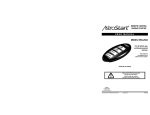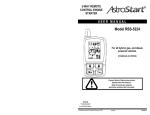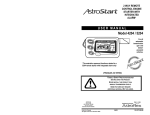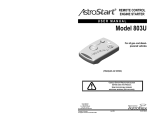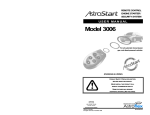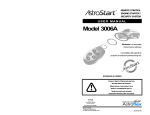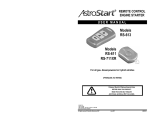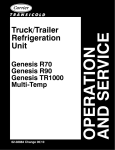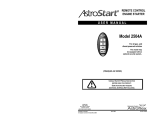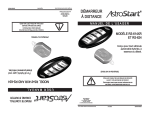Download AstroStart 903U User manual
Transcript
®
2-WAY REMOTE CONTROL
ENGINE STARTER
USER MANUAL
MODEL RSS-5225
For all hybrid, gas- and diesel-powered
vehicles.
2-WAY SST 5-button REMOTE STARTER
with LCD display.
CONSULT SAFETY PRECAUTION SECTION
BEFORE USING THIS PRODUCT.
SOME FEATURES MAY REQUIRE
ADDITIONAL MATERIAL (NOT INCLUDED).
(FRANÇAIS AU VERSO)
PATENT NOS
CAN 1.130.426
USA 4.345.554 - 5.614.883
- 5.617.819 - 5.673.017
AND OTHER PATENTS PENDING
All rights reserved © Directed Electronics Canada Inc. 2010
February 2010
5225
GOVERNMENT REGULATIONS
This device complies with the Industry Canada Radio Standards Specification RSS 210. Its use is authorized only on a no-interference, no-protection basis; in
other words, this device must not be used if it is determined that it causes harmful interference to services authorized by IC. In addition, the user of this device
must accept any radio interference that may be received, even if this interference could affect the operation of the device.
This device complies with Part 15 of the FCC rules.
Operation is subject to the following two conditions:
(1) this device may not cause harmful interference and
(2) this device must accept interference that may cause undesired operation.
This equipment has been tested and found to comply with the limits for a class B digital device, pursuant to Part 15 of the FCC Rules. These limits are designed
to provide reasonable protection against harmful interference in a residential installation. This equipment generates uses and can radiate radio-frequency energy
and, if not installed and used in accordance with the instruction manual, may cause harmful interference to radio communications. However, there is no
guarantee that interference will not occur in a particular installation. If this equipment does cause harmful interference to radio or television, which can be
determined by turning the equipment OFF and ON, the user is encouraged to try to correct the interference by one or more of the following measures:
Reorient or relocate the receiving antenna.
Increase the separation between the equipment and receiver.
Connect the equipment to an outlet on a circuit different from the one the receiver is connected to.
Consult the dealer or an experienced radio / TV technician for help.
Warning:
Changes or modifications not expressly approved by Directed Electronics Canada Inc. could void the user's authority to operate the equipment.
CANADA
188, St. Francois-Xavier
Delson, Quebec
J5B 1X9
www.astrostart.com
1
THANK YOU FOR CHOOSING AN ASTROSTART REMOTE CAR STARTER!
Like you, Directed Electronics Canada Inc. is concerned with the environment.
This is why we suggest using the two-minute runtime
when you remote-start your vehicle to warm up engine fluids.
We take this opportunity to remind you to properly defrost your windows
and remove all the snow from your vehicle before driving on public roads.
Rolling igloos are extremely dangerous!
We wish you an excellent journey with your remote engine starter!
USER GUIDE FOR RSS-5225 REMOTE ENGINE STARTER.
The RSS-5225 is a Bidirectional remote engine-start system. This means that it can both command the vehicle and return an acknowledgment of its status.
An optional alarm kit (P/N ALA-OP) can be added to the system. If this is the case, functions inherent to the alarm system described in this manual will be
attributed to it. The functions relative to the safety system described in this manual apply only to the remote starter to which an alarm kit has been added. The
RSS-5225 offers a keyless entry feature allowing the user to operate the door locks as well as to access the trunk of the vehicle. These features are optional and
may require additional parts and/or wiring during installation.
Table of contents
SAFETY PRECAUTIONS ____________________________________________________________________________ 3 PREPARING SYSTEM --------------------------------------------------------------------------------------------------------------------------------------- 3 SAFETY SEQUENCE FOR MANUAL TRANSMISSION VEHICLES -------------------------------------------------------------------------------------- 4 THE 2-WAY REMOTE CONTROL _____________________________________________________________________ 5 THE BATTERY ____________________________________________________________________________________ 5 LOW BATTERY ---------------------------------------------------------------------------------------------------------------------------------------------- 5 CONFIRMATIONS EMITTED BY THE REMOTE __________________________________________________________ 7 LOCK/UNLOCK COMMANDS AND ALARM SYSTEM ARMING/DISARMING --------------------------------------------------------------------------- 8 START COMMANDS _______________________________________________________________________________ 9 STARTING THE ENGINE ------------------------------------------------------------------------------------------------------------------------------------ 9 SETTING THE REMOTE CONTROL ---------------------------------------------------------------------------------------------------------------------- 10 PAGER ------------------------------------------------------------------------------------------------------------------------------------------------------ 11 ADVANCED FEATURES ----------------------------------------------------------------------------------------------------------------------------------- 11 TABLE OF COMMANDS ----------------------------------------------------------------------------------------------------------------------------------- 13 SECURITY SYSTEM---------------------------------------------------------------------------------------------------------------------------------------- 14 DETERRENTS ___________________________________________________________________________________ 14 ZONE CODES----------------------------------------------------------------------------------------------------------------------------------------------- 16 SECONDARY FUNCTIONS _________________________________________________________________________ 17 OTHER COMMANDS --------------------------------------------------------------------------------------------------------------------------------------- 17 UTILITY COMMANDS------------------------------------------------------------------------------------------------------------------------------------ 18 START FAIL CODES ______________________________________________________________________________ 19 CODE LEARNING OF ADDITIONAL TRANSMITTER(S) __________________________________________________ 19 SAFETY CHECKS ________________________________________________________________________________ 19 HOOD SWITCH --------------------------------------------------------------------------------------------------------------------------------------------- 19 GEARSHIFT CHECK APPLICABLE TO AUTOMATIC TRANSMISSION VEHICLES ------------------------------------------------------------------ 20 GEARSHIFT CHECK APPLICABLE TO MANUAL TRANSMISSION VEHICLES ---------------------------------------------------------------------- 20 REPLACING OR BOOSTING THE VEHICLE BATTERY __________________________________________________ 20 GLOSSARY _____________________________________________________________________________________ 21 2
SAFETY PRECAUTIONS
Before using this product, please carefully read the following safety precautions.
GENERAL RULES
•
•
•
•
•
•
•
•
•
•
•
•
•
•
•
•
Never perform a remote start when a person or animal is inside the vehicle.
Do not allow any person or animal to remain inside the vehicle when the engine is running under remote starter control (continuous mode).
Immediately report any malfunction to the AstroStart dealer that performed the installation.
Under no circumstance can this product or its use be modified.
Always turn off the main switch when the vehicle is parked in an enclosed, unventilated area or when in for servicing.
Always turn off the main switch when not using the remote starter for extended periods.
Keep remote controls away from children.
Have the engine tuned regularly to ensure optimal performance of your remote starter.
Make sure that the windshield wipers and the headlights are turned off before leaving vehicle.
Regularly check safety features that stop engine (see SAFETY CHECKS on page 19).
Make sure you comply with all local regulations, which may prohibit leaving your engine running when the vehicle is unattended in a public place.
To ensure continued safe operation of your remote starter, ask your AstroStart dealer to periodically check and/or tune the remote starting system.
Always advise service personnel that your vehicle is equipped with a remote starter.
We strongly recommend that you have your remote starter checked annually. Contact a dealer in your area.
All users of the vehicle should be aware of the safety precautions and operation procedures.
Make sure that the warning sticker is present on the driver's window.
SPECIFIC rules FOR MANUAL TRANSMISSION VEHICLES
•
•
Make sure that the parking brake is operational, i.e. it prevents the vehicle from moving.
If the shift lever is accessible without having to open a door of the vehicle (for example, by entering via the liftgate or rear hatch) or in the case of a
convertible vehicle, it is strongly recommended to have a motion detector (microwave) installed with the system. This device prevents the engine
from starting should any activity be detected near the gearshift.
PREPARING SYSTEM
When you exit the vehicle, you need to prepare the remote starter for its next use.
•
If the vehicle is equipped with a manual transmission, make sure that the remote starter system has detected a valid safety sequence.
•
If the vehicle is equipped with an automatic transmission, make sure that the transmission lever is in the "P" (Park) position.
•
Set heating/air conditioning controls to desired position (when the remote starter starts your engine, it will also turn on your climate control system).
•
Turn your windshield wipers to the OFF position to avoid strain on the mechanism should a start command be sent to the vehicle when, for example,
snow prevents the wipers from moving.
•
Make sure that the headlights are turned OFF.
•
Be sure not to leave your keys inside the vehicle. Certain rearming functions can cause the doors to lock automatically.
3
SAFETY SEQUENCE FOR MANUAL TRANSMISSION VEHICLES
Your remote starter was designed to force you to perform a series of actions that will ensure that the gearshift lever is in the neutral position when you exit the
vehicle. This series of actions is called a "Safety sequence" and is aimed at preventing remote starting in unsafe situations.
Should the rear hatch, liftgate or any door be opened at any time, the intrusion will be detected and the engine will not start. In such cases, the sequence must be
repeated to allow for an eventual remote start.
The system offers two execution modes for the sequence. These options must be set at the time of installation. The first mode is initiated by the parking brake
and the other by the remote control.
The safety sequence must be performed as follows.
Sequence activated by the parking brake
.
1.
2.
While the engine is running (key in ignition switch), apply the brakes and hold the pedal down.
Move the gearshift lever to neutral.
3.
Once
Twice
Apply the parking brake
Note: The system can be set - at time of installation - to require that the parking brake be applied once or twice. If set for two actuations, pause one
second between the two.
Remove the key from the ignition (the system keeps the engine running).
Exit the vehicle.
Within 60 seconds, close all doors.
The system will stop the engine (except if Turbo Mode or Continuous Mode is active). The parking lights blink once (1) to confirm the sequence is valid
(the vehicle is ready for a remote start command).
4.
5.
6.
7.
Sequence activated by the remote control
1.
2.
3.
4.
5.
6.
.
While the engine is running (key in ignition switch), apply the brakes and hold the pedal down.
Move the gearshift lever to neutral.
Apply the parking brake.
Press the
button on your remote control.
Remove the key from the ignition (the system keeps the engine running).
Depending on the programmed option:
Within 60 seconds, exit the vehicle,
close back all the doors then, using
the remote, send the STOP command.
Note that the Turbo mode is
not available with this option.
Within 60 seconds, exit the vehicle
then close back all the doors.
The system will stop the engine
except if either the Turbo mode
or the continuous mode is activated.
The parking lights will blink once to confirm that the sequence is valid (the vehicle is ready for a remote start command).
NOTES: If you release the brake pedal and press it once more during or after the execution of the safety sequence, the safety sequence will be invalidated and
any remote start will not be possible.
If the engine stops when the key is removed from the ignition, the safety sequence is invalid. Perform a new safety sequence. If the problem persists, consult
your installer.
4
THE 2-WAY REMOTE CONTROL
The remote control can control three separate vehicles. A maximum of four remote controls can be assigned to a vehicle. See your dealer for additional remote
controls.
Front view
Side view
Antenna
LCD
screen
Side buttons
Mini-USB
Port
Programming
Lock button
Remote Start
Status / Trunk
Unlock button
FIG 1
USING YOUR REMOTE CONTROL
To send a command, press for one second on the appropriate button. The remote control beeps when a button is pressed (if this option is on). A command may
not be sent if the button is not pressed long enough.
¾ Advanced: Your remote control can command three separate vehicles (additional systems required). To select a different vehicle, hold the “P”
button (
), located on the side of the remote, for 1.5 seconds.
Advanced: Your system may be programmed to distinguish between two groups of remote controls (maximum two remotes per group). These
groups let you activate predefined settings (seat, mirror and other) when unlocking certain vehicles (additional optional equipment required).
The range of your remote control can be affected by a weak battery, interference from nearby metal structures, “hydro” poles, electronic devices (with magnetic
fields), or crowded parking lots. If no confirmation is received in a given location, move away from the sources of interference and activate the "Status" command
(
on the side of the remote). The start module will inform you of the status of door locks, the alarm and of the engine.
¾
Note that the communication between the vehicle and the transmitter operates in only one direction at a time. This is why it is recommended to wait for
confirmations. Otherwise, communications could be cancelled out.
OUT OF RANGE
If the vehicle is out of range, the remote will emit a soft chirp after three (3) seconds and will show the “X” icon to indicate that the command has not been
received.
THE BATTERY
Your remote is powered by an internal rechargeable battery that can only be serviced by an authorized Directed dealer. Due to transit and storage time prior to your
purchase, the battery charge may have depleted. To ensure proper operation, check the battery level and connect the battery charger if not fully charged. See the
Battery Information and Status Screen Icons sections for more information about the battery.
LOW BATTERY
Once the low battery alerts begin (the text field flashes low bat and the remote beeps), they will continue to command the system for a few days but should be
charged at the earliest opportunity.
5
CHARGING THE REMOTE CONTROL
1.
Plug the AC adapter into a 110V AC outlet. Insert the mini-USB connector into the mini-USB port located on the side of the remote control (see figure 1,
page 5). The text field will display “CHARGE” to indicate that the remote control is charging (The remote remains operational while charging. It can
command the system).
2.
Once fully charged, the text field will display “FULL”.
3.
The remote control is then ready for use. Disconnect the mini-USB end from the remote control first and then the AC adapter from the AC outlet.
Note
Warning!
If the battery is excessively depleted when the charger is connected, functionality may be
delayed while it charges to the minimum voltage required to operate the display, after
which normal charging resumes.
NEVER connect the supplied AC adapter to products other than the remote control. It
is a high current device designed specifically for rapid charging and may cause
severe damage or explosion when connected to any other products.
Charging the battery when the temperature is below 0°C (32°F) or above 45°C
(113°F) may cause severe battery damage and/or reduce battery life. Avoid placing
the remote control in areas exposed to extreme cold or heat (direct sunlight) when
charging the battery.
BATTERY LIFE
The remote control has many features that make it one of the most unique remote controls on the market today, including superior long range communication.
The default feature settings provide for excellent battery charge duration. However, to maximize this duration between charges, the following suggestions will
help:
•
Turning Paging off. The remote will not wake up to check for messages with Paging off in the Setup Remote menu.
Caution! The remote will not receive alert messages from the system.
•
Turn Beeping off. The button beeps are off by default, but they can be turned on in the remote setup menu if desired. However, the melodies are
unaffected by the beeps settings and will still play normally.
BATTERY DISPOSAL
Directed Electronics cares about the environment. If you need to dispose of the battery, please do so in accordance with your
municipal requirements for battery disposal, or return it to Directed Electronics at:
Directed Electronics Canada Inc.
188, St. François-Xavier street,
Delson, Quebec
J5B 1X9
(Shipping and/or handling costs are the sole responsibility of the owner/sender and will not be covered by Directed Electronics).
6
CONFIRMATIONS EMITTED BY THE REMOTE
AN AUDIBLE AND A VISUAL CONFIRMATION ARE EMITTED EACH TIME A COMMAND IS TRANSMITTED.
The LCD displays the vehicule status at all time. It is refreshed on every transmission or when the status of the vehicle changes, unless the “Status confirmation”
function is disabled. The display shows the last confirmation received.
The following diagram shows the usefulness of each icon of the display.
Descriptions in bold letters show confirmations pertaining to the security system’s functions.
Large remote start icon
Small remote start icon
Text field
FIG 2
1
1.
Locked (without Valet)
12.
Car Door (Trigger)
2.
Locked with Valet
13.
Hood (Trigger)
3.
Unlocked (without Valet)
14.
Trunk (Trigger)
4.
Unlocked with Valet
15.
Sentinel mode ON
(L-Temp mode)
5.
Alert
16.
6.
Engine starting
(Large remote start icon)
17.
Engine running
(Small remote start icon)
Manual Transmission
Sequence Enabled
7.
Battery Status
18.
Car 1
8.
Transmitting
19.
Car 2
9.
Receiving
20.
Car 3
10.
Out of Range / No answer
21.
Armed
11.
Shock Sensor
22.
Utility outputs status
23.
Clock, messages1
Text Field
Not all the messages in the text field refer to the security system’s functions.
7
Two types of confirmations are displayed on the remote:
Command confirmation: These confirmations are command acknowledgements. The icon corresponding to the command is displayed to confirm the reception
of the command.
Status confirmations: These confirmations are displayed when the status of a monitored zone changes: door opening, alarm state, etc.
Command confirmations are returned immediately following a command transmission, whereas the status confirmations may be returned up to 12 seconds after
the event happened.
Out of range: In the event that the environment prevents confirmations from being received by the remote control, the “X” icon appears.
Note: You can refresh the LCD screen display by pressing on any button or press the status button.
CONFIRMATIONS EMITTED BY VEHICLE
Confirmations emitted by the vehicle are sent as soon as the command is received by the start module. In most cases, your remote starter will confirm that the
command has been received, either by sounding the horn, the siren, or by flashing the parking lights.
The confirmations emitted by the parking lights are mandatory while those emitted by the horn and the siren are optional (programmable) and can require
connections and additional equipment at time of installation. Many of these confirmations depend on the system’s status when the command is emitted. Refer to
paragraphs relating to each command for more details on confirmations.
LOCK/UNLOCK COMMANDS AND ALARM SYSTEM ARMING/DISARMING
If your vehicle is equipped with electric door locks, several functions can be operated by remote control.
These features are optional and may require purchasing additional equipment. Consult your dealer for advice.
Arming and disarming the security system also controls the Lock/Unlock functions. The arming/disarming functions only apply to models equipped with a security
system.
The following systems can be controlled:
•
Door locks
•
Trunk or hatchback release
•
Interior lights
LOCK / ARM
Press the
button: the doors are locked and the alarm system is armed. The parking lights flash once and the siren chirps once (if programmed during
installation) to confirm that the command has been received and that none of the protected zones are in violation.
The parking light confirmation is sent as many times as the command is repeated, so you are sure that the system has received the command. The audible
confirmation is also repeated (siren or horn, depending on programming) if option "Confirmation on 2nd lock" is activated (during installation).
If a zone is in violation during arming, the confirmation warning you is different (3 flashes or chirps). See table of alarm codes to know which zone is in violation.
UNLOCK / DISARM
Press the
button. The doors are unlocked and the alarm is disarmed. The parking lights flash and the siren chirps twice to confirm that the command has
been received and that no alarm condition was generated during your absence.
If there was a violation, the confirmation would be different (4 flashes or chirps). See table of alarm codes to know which zone generated an alarm condition.
The “Unlock“ function can be programmed and connected in such a way that the first Unlock command only unlocks the driver's door, while a following Unlock
command unlocks the other doors (optional connection during installation).
The dome light will turn on for 30 seconds every time the Unlock command is sent out (not applicable in semi-passive mode)(optional connection during
installation).
This 30-second duration is cancelled when the Lock command is sent out, when the brakes are applied or the key is inserted in the ignition and turned to the
RUN position.
TRUNK RELEASE
(This feature must be enabled during the installation).
Press the
button and hold it for 4 seconds. The trunk is released and the parking lights flash three times to confirm that the command has been executed.
The remote shows the trunk opening.
The trunk cannot be released if the ignition key is in the RUN position.
Furthermore, if the alarm is armed and the system is not equipped with an additional sensor capable of detecting trunk release (optional equipment not included),
the opening of the trunk with a remote control will not be possible.
In this case, the parking lights flash once and the remote control vibrates once to confirm that the command has been received, but the trunk could not be
released.
If you are not sure you have received confirmation, repeat the command. The system will repeat the confirmation as often as you wish.
If your vehicle is equipped with a factory installed security system and that this system is neutralized by the trunk release command, remember to rearm it after
the trunk is closed ("Lock" command).
8
SYSTEM EQUIPPED WITH AN ADDITIONAL SENSOR
.
If your system is equipped with a sensor designed to monitor the status of the trunk (added at time of installation), the parking lights will flash three times to
confirm that the command was received. When the trunk is released, 3 chirps are emitted to warn that the alarm will not take into account the status of this zone
or the shock sensor's zone for the next 5 minutes. If you do not release the trunk within 10 seconds, the system will rearm the trunk automatically.
The timer is reset each time the command is repeated, which allows a new 5-minute period to close the trunk lid.
The system will sound a chirp when the trunk is closed to confirm it has been rearmed. If the trunk is opened for more than 5 minutes, the system switches to the
alarm status.
AUTOMATIC LOCK/UNLOCK
Programmable as Active or Inactive during installation.
This function locks the doors when the ignition key is in the RUN position, the engine is running and the brakes are applied.
The doors are unlocked when the key is turned from RUN to OFF, or when the Continuous Mode (Including Turbo Mode) is activated, or when a safety sequence
is detected.
If the Unlock function is set to unlock only the driver's door on the first command, the Automatic Unlock function will unlock the driver's door only. If the dome light
is connected to the system, it comes on when an Automatic Unlock occurs.
This function is: Active
Inactive
.
START COMMANDS
STARTING THE ENGINE
To start the engine, press the
button.
The system automatically adjusts the ignition duration for your type of vehicle (gas or diesel); the parking lights flash once (for four seconds) then stay on when
the engine is running.
If more than one command is sent, each successive start command resets the runtime. Parking lights flash once to confirm the command has been received and
the horn sounds once (programmable during installation) to let you know the engine is already running.
When the start command is transmitted,
the system immediately sends out one of two possible confirmations:
1.
2.
the vehicle can start.
the vehicle will not start
The vehicle won't start if, for example, the hood is open. In this case, the
parking lights flash and the text field shows “remote start failed”. The startfail codes are available on page 19.
If the vehicle starts, the system will automatically send another
confirmation, with a melody, after a few seconds. If Runtime display option
is selected, it displays the remaining runtime in the text field. Otherwise,
the clock time is displayed.
System starting
Large Remote
Start icon appears
on remote
System not starting
The parking lights
Error code,
flash and the text
field displays an
text field
error code
Successful start
Small Remote
Start icon and a
melody is played
IF THE ENGINE DOES NOT START
If your system cannot start the engine at the first attempt, it will wait a few seconds then try again. It could try again twice depending on failure reason.
After three attempts, it will shut down automatically and wait for a new command.
9
UPON ENTERING YOUR VEHICLE...
DO NOT TURN IGNITION KEY TO START POSITION.
Automatic transmission vehicles
To avoid turning the engine off when taking
place behind the steering wheel, do not apply
the brakes until you have placed the key in the
ignition and turned it to the RUN position.
Drive as usual.
STOP
Manual transmission vehicles
To avoid turning the engine off when taking place behind
the steering wheel, do not apply the brakes and do not
remove the parking brake until you have placed the key in
the ignition and turned it to the RUN position.
Drive as usual.
+
When the engine is running on a remote start, you can turn it off by performing a stop command.
This command also terminates panic mode and the alarm condition without disarming the security system.
SETTING THE REMOTE CONTROL
Certain functions on the remote may be set to your convenience.
To access the remote control programming mode, press the
button located on the side of the remote and hold it for four (4) seconds. The remote will emit
one long tone. Release the button. The text field will change to the remote settings menu.
In the menu, the three (3) side buttons (
,
Remote Start and Status) become directional
arrows to navigate through the options.
Pressing the Status
button goes one step
up on the same menu
level.
Setup level
(main menu)
Second level
(clock selected
for example)
Third level
(hour selected
for example)
Setup
Keypad
Hour
Page
Light
=
Pressing the Remote
Start button goes one
step down on the
same menu level.
Button
Pair
Clock
Back
Color
Car
=
Pressing the
button confirms a
selection. It also
navigates
forward
through menu levels.
=
or
Confirm
Sensor
Exit
Start
Minute
Review
Exit
**Back to
Keypad**
Use the Remote Start and Status buttons as arrows to modify the setting.
Press
to confirm selection.
Confirming a setting brings back to previous level (second level in example).
FIG 3
10
REMOTE TRANSMITTER PROGRAMMING TABLE
SETUP
SETTINGS
COMMENT
ON (Locked)
OFF (Unlocked)
ON
OFF
Upon "Status" command
Upon any command
Never
ON
OFF
Hour
Minute
1 to 7
Keypad
Page
Light
Button
Clock
Colour
Keypad Lock/Unlock
To receive vehicle page information.
Turn backlight on or off
Button sounds
To adjust clock time
To choose the desired backlight colour
To choose the vehicle number
Car
1
to
3
OR
Auxiliary sensor icon
Start
Trunk
Motion sensor
Glass sensor
Tilt sensor
Ultrasonic sensor
Clock
Run time
OR
If remote option is changed, the module option (in vehicle)
must also be changed.
To display desired setting when car is running.
Note: Highlight is by default.
PAGER
The system is equipped with a function called ‘Pager’. This function sends a general call to all remotes linked with the system asking to get to the vehicle or to
perform a task previously established.
Paging
To send a general call, the user must press the ‘Valet’ switch and hold it for 3 seconds while engine is stopped and key is not in the ignition, or while engine is
remote started (see ‘Valet Mode’ on page 17)(The valet switch is a small push button hidden under the dash board).
The parking lights on the vehicle blink once to confirm the call was sent out.
All remote controls (maximum: 4) located within the radio frequency range of the vehicle will begin to chirp. To silence the remote, press any button.
ADVANCED FEATURES
STATUS
When this command is sent, the vehicle checks the status for the engine, the protection zones and for the locks, then retransmits this information to the remote
control. The results show up on the LCD display through a combination of pictograms and text in the text field.
When the remote control receives a confirmation, it flashes the relevant pictograms and vibrates twice.
If the vehicle is out of range, the remote control will give a soft chirp after three (3) seconds, indicating that either the vehicle or the remote could not receive the
command.
ENGINE RUNTIME
Your engine will stop automatically after a preset runtime: 4 min.
doubled for diesel vehicles.
The parking lights stay on as long as the engine is running.
, 8 min.
or 18 min.
, depending on settings during installation. These durations are
TRIGGER INPUT
Your remote starter is equipped with a trigger input. This input can be connected to another remote control device or to an AstroStart
RST-2 timer (optional), part number 310-903-502.
If this input is connected, consult the device's manual or ask your technician which command controls its Start/Stop function.
Commands received on this input are ignored while engine is running on a remote start.
All Start/Stop commands triggered on the input device act the same as for a remote control.
11
CONTINUOUS MODE
Continuous Mode function lets you remove the key from the ignition while leaving the engine running. This convenient feature allows you to leave your vehicle for
short periods while the climate controls remain on.
AUTOMATIC TRANSMISSION
VEHICLES
MANUAL TRANSMISSION
VEHICLES
To access Continuous Mode, send the Start command while the engine is idling (see STARTING THE ENGINE on page 9). If the
Turbo Mode is active, you must press a second time on the
button of the remote to set the runtime according to the preset
settings. The parking lights, engine and climate controls will remain on for the duration of the programmed runtime.
To access the Continuous Mode, send the Start command before removing the key from the ignition when performing the safety
sequence described on page 4. See “STARTING THE ENGINE” on page 9.
Note: Do not send the stop command if you perform the sequence activated by the remote control (Step 7). If the Turbo Mode is
on, it will be activated when the safety sequence is executed.
Remove the key, exit the vehicle and lock all doors. All safety devices will remain active.
If you return to your vehicle before the runtime has elapsed, just turn the key to the RUN position and press the brake pedal.
TURBO MODE
(Activated at time of installation)
This mode allows the engine to be left running at idle speed for a short period of time so that the turbocharger can cool down as recommended by certain car
manufacturers.
This mode activates the continuous mode at a reduced runtime (one or two minutes according to the programming).
To activate the Turbo Mode, press the
button for 2 seconds (refer to ‘Continuous Mode’).
WHAT STOPS THE ENGINE
For your safety, engine will not start or will stop if:
Your key is in the ignition (prevents Start cycle).
the remote control commands to stop.
the hood is open.
the brakes are applied.
the engine is over-revving (if programmed. Enable at installation).
the alarm detects intrusion.
the main switch is OFF.
the safety sequence is not valid (manual transmission vehicle only - the parking brake wasn’t applied, opening the door while the remote starter wasn’t
keeping the engine running).
MAIN SWITCH
The main switch is usually mounted under the dashboard. It is a toggle ON/OFF switch that is used to cancel start functions.
It does not disable other commands. Commands remain active (Alarm features, Locks, etc.).
LOW TEMPERATURE MODE
In Low Temperature (Sentinel) mode, the system starts your engine automatically when the temperature falls
below a preset level. This level is set during the installation (runtime durations are doubled for diesel engine
vehicles).
,
When the engine turns off, it waits for 2½ hours before starting up again for a duration of 4 min.
8 min.
or 18 min.
The temperature threshold is set to 9
-5 °C (23 °F)
-20 °C (-7 °F)
-15 °C (5 °F)
-30 °C (-22 °F)
. Then, the system waits another 2½ hours before starting the engine again if temperature still is below the preset level.
To activate/cancel Low Temperature mode, press the
and
buttons simultaneously. Applying the brakes also cancels the Low Temperature mode.
WHEN L-TEMP MODE IS ACTIVATED:
The parking lights flash 4 times, then, if the temperature is below the preset level, the engine starts.
If the temperature is above the preset level, system will wait until it goes below the preset level before starting up the engine.
In the case of a manual transmission vehicle, the system must have detected a valid security sequence to allow the activation of the Low Temperature mode.
(see “Safety sequence for manual transmission vehicles” on page 4).
If the system cannot execute the command (for example, the security sequence is not valid or the hood is open), the parking lights will flash 3 times.
WHEN L-TEMP MODE IS CANCELLED:
The parking lights will flash twice to confirm that the mode is cancelled.
12
TABLE OF COMMANDS
COMMANDS
BUTTON
5 START / CONTINUOUS MODE
5 STOP
+
5 LOCK / ARMING *
5 PANIC (BUTTON HELD FOR > 4 SEC.)
CONFIRMATIONS
SENT BY VEHICLE
HORN
PARKING LIGHTS
SIREN *
1
1
-
-
1
-
1
1/3
1/3/X
30 / 60 SEC.
OR
REMOTE
SMALL
STOP
LOCKED
PANIC
5 UNLOCK / DISARMING *
-
2/4
2/4/X
5 TRUNK (BUTTON HELD FOR > 4 SEC.)
-
3
3
UNLOCK
TRUNK
5 ACTIVATE / CANCEL
LOW TEMPERATURE MODE
+
-
2/3/4
-
5 ACTIVATE / CANCEL UTILITY 1
+
-
1
-
5 CAR FINDER
+
7
3
-
Car Finder
-
2/4
-
Valet On/Off
-
-
-
-
1
-
5 ACTIVATE / CANCEL VALET MODE
+
5 STATUS
5 ACTIVATE / CANCEL UTILITY 2
5 VEHICLE SELECTION (BUTTON HELD 1.5 SEC.)
+
L-Temp
ON REMOTE ONLY: 1 BEEP FOR CAR 1
2 BEEPS FOR CAR 2
3 BEEPS FOR CAR 3
OR
OR
* COMMANDS FOLLOWED BY AN ASTERISK (*) APPLY ONLY TO COMMAND UNITS EQUIPPED WITH A SECURITY SYSTEM.
THIS COMMAND TERMINATES THE RUNTIME, PANIC MODE AND ALARM STATUS.
ENTERS TEMPORARY VALET MODE IF ACTIVATED A SECOND TIME DURING REARMING DELAY.
START CONFIRMATION TAKES A FEW SECONDS, EXCEPT IF THE ENGINE IS ALREADY RUNNING.
AVAILABLE ON SUBSEQUENT COMMANDS, ONLY IF PROGRAMMED DURING INSTALLATION.
WHEN THE OPTION IS PROGRAMMED IN TRUNK MODE (OPTIONAL MATERIAL REQUIRED) AND THE TRUNK IS OPEN. THIS CONFIRMATION WILL REPEAT ITSELF EVERY
5 MINUTES UNTIL THE TRUNK IS CLOSED.
IF THE COMMAND CANNOT BE EXECUTED, THE PARKING LIGHTS FLASH ONCE, THE “TRUNK” ICON DOES NOT SHOW.
13
SECURITY SYSTEM
This section applies to an AstroStart safety system (optional) and should not be mistaken for the vehicle’s original system. On such a system, the remote can
only warn of an alarm status (Alarm Link) (optional connections).
This half-duplex remote control is in constant communication with your vehicle. Even if you do not ask for status, it will inform you by means of icons on your
remote that; a door has been opened for more than 5 minutes; that the engine has stopped; etc.
PROTECTION ZONES
Your security system can use up to six different monitoring devices simultaneously to protect your vehicle. These devices are connected to the system on
different inputs called protection zones. One of these zones can send an audible warning (7 chirps), while the other five generate an alarm condition, if the
system is armed.
PROTECTION ZONES
RESULTS
Pre-shock / Field (Warning)
Siren chirps (7 times)
Pre-shock / Field (more than 3 times in 3 min.)
Doors
Hood
Trunk
Additional sensor(s) [Glass, Tilt, Ultrasound]
Shock sensor
Ignition (key)
Siren ON for 30 or 60 second period, which can be repeated up to 4 times depending on
initial programming and whether violated zone is corrected or not.
Each period is separated by a 5 second pause (45 seconds for "Door" zone).
DETERRENTS
ACTIVE
When one of the monitoring devices detects a violation, the system reacts by activating up to four of the following deterrents simultaneously, depending on which
is connected:
the siren, parking lights, dome light and/or horn.
PREVENTIVE
Depending on the system’s configuration, the indicator light (optional at time of purchase) shows different alarm conditions (see "ZONE CODES" on page
16).It can also act as a deterrent if installed in a place visible from outside of the vehicle.
ALARM MODES
PRE-ALARM
The warning signal consists of 7 siren chirps.
If you set off the alarm by accident and do not want to alarm or disturb the whole neighbourhood, the "pre-alarm" mode is triggered three seconds before the
alarm condition; to give you time to disarm the system.
In this mode, the parking lights, siren and dome light go on and off intermittently for three seconds. The violation information will also be shown on your remote by
the dedicated icon.
ALARM CONDITION
When the system is in alarm condition, it activates the various deterrents connected to the alarm module.
An alarm condition remains active for 30 or 60 seconds, depending on initial programming, then the system pauses for five seconds (45 seconds for "Door"
zone). During this pause, it checks the protection zones again and restarts the alarm cycle if a zone still is in violation.
This cycle can be repeated up to four times. If the situation that caused the violation is corrected mid-cycle, the alarm stops at the end of the current cycle.
Information indicating that the system is in alarm condition will also be sent to your remote. An audible and visual confirmation will indicate which zone was
affected by the alarm, if at least one zone is in violation status. If no zone is in violation status (ex.: door was shut), only an audible confirmation will be emitted.
OPERATION
Your alarm system has three different operating modes: active, semi-passive rearming and passive rearming, depending on the initial programming. See the
relevant paragraph for the mode your system was configured in during the installation.
Following a rearming, the last remote that transmitted a command to the system will receive confirmation of the rearming.
ACTIVE
In active mode, the alarm must be armed and disarmed using the remote (see Table of Commands on page 13).
The alarm is armed as soon as the command is received, even if a zone is in violation when the command is received. If this is the case, the remote will emit a
loud chirp telling you that one zone is open. The alarm will still enable for the vehicle except for that zone. However, when that zone is returned to a normal
condition, it will then be armed.
This mode is always available, even if, during installation, your system was not configured for it.
14
SEMI-PASSIVE REARMING
In semi-passive mode, the alarm must be armed and disarmed using the remote (see Table of Commands on page 13).
In this mode, the alarm rearms automatically 25 seconds after disarming (rearming cycle) if doors all remain closed. The indicator light flashes rapidly to indicate
that the system is in a rearming cycle.
Note: If the vehicle is equipped with power locks interfaced with the system, a device can be added to prevent doors from locking if the key is still in the ignition
during rearming. If applicable, this device allows system to be armed but cancels locking.
The key detection device is , is not installed on this vehicle.
The following table shows the effect of each zone on the rearming cycle.
PROTECTION ZONE
Hood
Additional sensor
Shock sensor
EFFECT ON REARMING CYCLE
These three zones prolong rearming cycle as long as they remain in violation.
Activated by ignition key: Cancels rearming
Activated by remote starter: No effect
Doors 2
This zone cancels rearming completely
Warning
No effect
Applying the brakes or activating the Temporary Valet Mode (see page 17) cancels rearming.
Ignition
PASSIVE REARMING
In passive rearming mode, opening a door triggers the rearming cycle.
The alarm will be armed 30 seconds after checking that all protection zones are in normal condition. This 30-second period is called the "rearming cycle".
If a zone detects a violation during the rearming cycle, the countdown stops. It will restart at 30 seconds when all the zones are back to their normal conditions.
During the rearming cycle, the indicator light flashes rapidly.
After five seconds, the system sends an audible confirmation (siren chirps once) indicating that the system will arm after 25 seconds. After this delay, the alarm is
armed and a second confirmation (the siren chirps once and the parking lights flash once) is sent out, indicating that the system is armed.
If you wish to remain in the vehicle without driving off, you can cancel the rearming cycle by applying the brakes.
When you exit the vehicle, the cycle resumes and the system arms automatically.
If you disarm the system and do not open a door within 1 minute, it rearms itself automatically. The following table shows the effect that each zone has on the
rearming cycle.
PROTECTION ZONE
Hood
Doors
Additional sensor
Shock sensor
Ignition
Warning
EFFECT ON REARMING CYCLE
These four zones prolong rearming cycle as long as they remain in violation.
Activated by ignition key: Cancels rearming
Activated by remote starter: No effect
No effect
Applying brakes or turning key in ignition to RUN position cancels rearming (until a door is opened, which causes rearming cycle to restart from the beginning).
See also "TEMPORARY VALET MODE" (page 1717) and "DOME LIGHT DURATION" (page 21).
You can only disarm with the remote control by pressing the
button (see Table of Commands on page 13).
The system is disarmed immediately and restarts the rearming cycle from the beginning.
TO TERMINATE AN ALARM CONDITION
You can terminate an alarm condition by pressing the
alarm condition without disarming the system.
button, which also disarms the system. Pressing the
button or the stop command will terminate the
2
Door openings and closings are simulated for factory system when a Directed Electronics Canada Inc. system is present. Consequently, if the vehicle is equipped with a factory security system and its runtime
expires during the rearming cycle, it is reactivated but not the Directed Electronics Canada Inc. security system.
15
CONFIRMATION
When the alarm is armed, one chirp of the siren and/or flash of the parking lights means that all protection zones are in normal condition and that the system is
ready.
The remote control sends the following confirmation
with one soft chirp.
Three siren chirps or parking flashes means that one or more zones are in violation (i.e. at least one door is opened). At that time, the remote sends the same
confirmations but with a high chirp, reminding you to correct the violated zone.
Once the zone is corrected (i.e. door is closed), the system sends another confirmation (one chirp or flash if all zones are in normal condition, three chirps or
flashes if another zone is in violation).
If a zone is in violation when the system is armed manually (using the remote) and the cause of the violation is not corrected, the alarm will still arm but this zone
will not be able to generate an alarm condition. See also "DOME LIGHT DURATION" on page 21.
When you disarm the alarm, two chirps or flashes indicate that no one tried to break into or do anything to your
Condition
Confirmations
vehicle, and four chirps or flashes indicate that an alarm condition occurred during your absence. Your remote will
Without violation
2 soft chirps
also indicate this with chirps as shown in the following table.
With violation
1 loud chirp
The following table summarizes this section.
CONFIRMATION
chirps or flashes
1
2
3
4
MEANING
System armed, no zone in violation.
System disarmed, no violation detected.
System armed with zone in violation. Indicator light indicates which zone.
System disarmed with violation detected. Indicator light indicates cause of alarm condition.
INDICATOR LIGHT
The Indicator light flashes a specific number of times to indicate different alarm conditions when arming and disarming the system (depending on settings during
installation).
It can also act as a deterrent if installed in a place visible from outside the vehicle.
DURING ARMING
The indicator flashes codes for zones in violation (i.e. at least one door is opened).
Only one code is shown at a time. If more than one zone is in violation during arming, the code changes when the zone shown is corrected (example: door is
closed).
DURING DISARMING
The indicator light flashes the code for the last zone that generated the alarm condition.
button.
The code is shown when you press the
This code is repeated until you apply the brakes.
The following table shows the meaning of the zone codes (number of flashes).
ZONE CODES
Flashes
1
2
3
4
5
6
7
8
Zone indicated
System is armed.
A door is/was open.
Hood is/was open.
Alarm condition is/was detected on shock sensor input.
Key is/was in ignition position (RUN).
Alarm condition is/was detected on additional sensor input.
Additional sensor monitors status of ____________________________________________________
Loss of power (+12V battery supply was removed).
Alarm status is/has been detected on pre-shock sensor input.
THE INDICATOR CAN SHOW TWO OTHER CONDITIONS:
CONSTANT DIM LIGHT
Indicates that alarm is permanently disarmed.
See "VALET MODE" on page 17.
RAPID FLASHES
Indicates that system is in rearming cycle.
See "SEMI-PASSIVE REARMING" and "PASSIVE REARMING" on page 15.
16
SECONDARY FUNCTIONS
ANTI-LOCK
When connected, this function prevents the system from locking the doors during the automatic rearming if the key is in the ignition.
It can also be connected to a switch to select automatic locking as ACTIVE or INACTIVE.
TEMPORARY VALET MODE (ALARM)
This mode is used to cancel the automatic rearming until next rearming. I.e. the system will not rearm automatically after 30 seconds. However, the system goes
back to normal next time it is rearmed (with delay).
You will find this mode useful when fuelling up or working on your vehicle.
button during the rearming cycle (the indicator light flashes rapidly).
To activate Temporary Valet Mode, press the
When the light stops flashing, it confirms that the Temporary Valet Mode has been activated.
To cancel this mode, place the ignition key in the RUN position then remove it; the passive rearming is reactivated when you open a door.
You can also arm the system using the remote, which cancels the Temporary Valet Mode.
VALET MODE
This mode is used to deactivate the alarm permanently when you take your vehicle in for servicing, for example. It can be activated or
deactivated either by the remote (see table of commands, page 13) or by the Valet switch. See also Pager on page 11.
The Valet switch activates the Valet Mode or terminates the alarm condition when your remote control is not available (lost, dead
batteries, etc.).
This switch must be installed in a hidden place known only to regular users of the vehicle.
Ask your installer to tell you where it is.
TO ACTIVATE THE VALET MODE, place the ignition key in the RUN position (do not start the engine), then press the Valet switch for about 3 seconds. The indicator
light will come on at half-brightness for 15 seconds or less and the parking lights will flash four times to confirm that the mode was enabled. The indicator light
comes on again when the engine is stopped or when certain commands are received, reminding you that the Valet Mode is active.
TO DEACTIVATE THE VALET MODE, place the ignition key in the RUN position (do not start the engine), then press the Valet switch for about 3 seconds. The
indicator light goes out and the parking lights flash twice to confirm that the mode was disabled.
Notes:
If you perform both sequences one after the other, you need to pause for 3 seconds between the two sequences.
The Valet Mode is automatically deactivated when the key is turned to the RUN position and/or the engine is remote started for the tenth time. This is to prevent
the Valet Mode from being left on for long periods.
OTHER COMMANDS
ANTITHEFT (CIRCUIT DISABLER)
Programmable as Active or Inactive during installation.
Your Remote Starter is equipped with an antitheft system. This system, when enabled, consists of a control that cuts all circuits required to operate your vehicle
(optional connection).
There are two types of antitheft systems.
“PASSIVE ARMING" TYPE ANTITHEFT
/
This type of antitheft system arms automatically when the ignition key is turned from RUN to OFF and remains OFF for one minute. It can also be armed
manually by sending a Lock command (unless the ignition key is in the RUN position).
DISARMING
The antitheft system is disarmed for one minute when you send an Unlock command.
If the ignition key is not turned to the RUN position within one minute, the system automatically rearms, thus preventing an intruder from starting your vehicle,
even with the ignition key. The indicator light (optional) blinks rapidly during the rearming, then continuously when the antitheft system is armed.
It can be connected so that the horn sounds if an intruder tries to start your vehicle when the antitheft is armed.
“ACTIVE" TYPE ANTITHEFT
/
This type of antitheft system is armed by sending a ‘Lock’ command (unless the ignition key is in the RUN position) and is disarmed by sending an ‘Unlock’
command. The indicator light (optional) blinks continuously when the antitheft system is armed (if the AstroStart security system is not armed).
VALET MODE (ANTITHEFT)
The Antitheft function can be deactivated for the same reasons and in the same way as the Antitheft system. See "Valet mode" details on page 17.
PARKING LIGHTS STATUS
The system can advise you that the vehicle’s lights have been on for more than ten seconds after the engine was stopped (additional optional equipment
required).
The message is sent again after 30 seconds and then every two minutes for as long as the lights remain on.
This function is only available on gas-powered and hybrid vehicles.
17
INDICATOR LIGHT
An optional indicator light (LED) can be added to show the status of the safety sequence (on vehicles equipped with a manual transmission), of the safety
system, the antitheft system or of the Valet Mode.
See ‘Indicator Light’ in the ‘Safety System’ Section.
The following table shows the codes displayed by the indicator light when performing the safety sequence.
Repeated flashes
3 double flashes
2 double flashes
1 double flash
1 single flash
Fast (10 sec.)
Phase or Status
Start of sequence.
Door open.
Door closed (waiting for engine to stop).
Valid safety sequence (system is ready to receive a start command).
Invalid sequence (sequence must be started over from beginning).
UTILITY COMMANDS
These commands allow you to control most of the vehicle’s accessories depending on what was connected during the installation (headlights, defroster, etc.). For
more information, check with your technician.
To activate these functions, simultaneously press the buttons as shown in the following table. (Fill-up the blanks)
Commands
Buttons
Corresponding accessory
Duration
UTILITY 1 *
+
UTILITY 2
+
The accessory associated to each command is activated for the duration set at time of installation.
The delay can be cancelled by repeating the command.
* Programmable at time of installation: the “trunk” command can activate utility 1.
CAR FINDER
+
Press the
and
buttons simultaneously.
This function sounds the horn (short melody) and flashes the parking lights so you can locate your vehicle in a large parking lot.
PANIC
To activate the panic mode, press and hold either the
or the
button for more than 4 seconds.
This command activates all deterrents that are connected to the system, parking lights, horn, siren and dome light for 30 sec.
or 60 sec.
, depending
on programming made during installation.
Panic mode is used to attract attention if you are experiencing difficulties.
If you are inside the vehicle when Panic Mode is activated, press on the brake pedal to lock doors (optional connections required) and neutralize antitheft (60
sec. if doors were already unlocked). As long as the cycle is not over, applying the brakes resets the sequence from the beginning every time.
This command will not be executed if the engine is kept running by the ignition key. Use the stop command to abort panic mode.
18
START FAIL CODES
When a remote start attempt fails, it is possible to determine what caused the failure to start.
When this occurs, the remote emits a long error beep and vibrates twice.
The table below lists the various start fail codes. Note that this code is only displayed once.
Code
1
2
3
4
5
6
7
8
9
10
11
12
13
14
15
16
19
20
Failure to start details
Module has received a Stop command (remote, safety sequence or timer).
Brakes were applied during or after start sequence or module overload occurred.
Stopped by alarm.
Engine does not crank when starting sequence is initiated.
Start command ignored because hood is open.
Safety sequence not valid during start sequence.
Start command ignored because key is in ignition (in “Run” position).
Remote starter main switch is OFF.
Runtime has elapsed.
Remote starter attempted to start engine three times unsuccessfully.
Remote starter sensed engine was already running.
Engine is over-revving (RPM > 3000)(programmable at time of installation).
Engine not cranking fast enough during start sequence.
Security sequence has been invalidated by status of parking brake.
Security sequence has been invalidated by opening of one or more doors.
Internal failure of module.
Module does not detect manual interface.
Consult your dealer.
If any of these start fail codes persist, consult your dealer.
CODE LEARNING OF ADDITIONAL TRANSMITTER(S)
Four different remote controls can be programmed for a given vehicle. If a fifth remote is added, the fifth remote takes the place of the first.
Note: When the first code-learning command is sent, all the old codes are cleared out. Therefore, if you want to add a new remote, all the old ones must be
reprogrammed as well.
One or more remote transmitters can be added. To do this, you must follow these steps:
Before all, select the pairing mode in the remote’s settings menu.
o
Press
for approximately 4 seconds and select “Pair” (see FIG. 3 on page 10). The word “coding” will appear in the text field.
Open the hood. (the Hood switch must be present and operational. – See “Safety checks” below)
Place the key in the ignition and turn it to the “RUN” position
Apply the brakes once
You now have 10 seconds to turn the key from “RUN” to the “OFF” position 3 times.
If this sequence is correctly carried out, the control module flashes the parking lights (4 flashes). You may then proceed to the next step.
Press the
button on the new remote control (pre-set to “pairing” mode). When the access code of the new remote control is memorized, the
control module will confirm with flashing the parking lights (1 flash) and the remote will display “passed”.
Repeat the above procedures for each remote control that has to be programmed (up to 4 remotes).
Apply the brakes.
The new remote(s) is (are) now added to the system.
If your vehicle is equipped with a function that automatically sets the driver preferences (seat, mirrors, etc.) and the system is configured to control it, the remote
controls programmed in positions 1 and 2 will control the settings for the first driver and the remote controls programmed in positions 3 and 4 will control the
settings for the second driver. If you only have two remote controls, program the first one twice and the second one twice to occupy the four memory locations of
the system.
SAFETY CHECKS
In order to maintain a high safety standard, proceed with the following checks every month.
HOOD SWITCH
•
•
Remote start your vehicle.
Open the hood.
19
The engine should stop as soon as the hood is opened.
If the engine does not stop immediately, turn the main switch to the OFF position and leave it off until the situation is rectified. Contact your service center.
GEARSHIFT CHECK APPLICABLE TO AUTOMATIC TRANSMISSION VEHICLES
If the key must be in the ignition for the gearshift to be moved out of “P” (Park), your vehicle is safe as long as keys are kept away from children.
If, on the other hand, the gearshift can be put in gear without the key being in the ignition, proceed with this simple check.
•
Make sure that the parking brake is applied.
•
Put the gearshift in gear (D).
•
Remain in the vehicle and be ready to apply the brakes.
•
Start the vehicle with the remote starter.
•
Repeat these steps with the gearshift in every position other than Park and Neutral.
If the starter reacts within 90 seconds (which is not safe), turn the main switch to the OFF position and leave it off until the situation is rectified. Contact your
service center.
•
Make sure that the parking brake is applied.
•
With the gearshift in “P” (Park), start the vehicle with the remote starter.
•
Remain in the vehicle and be ready to apply the brakes.
•
Without applying the brakes, move the gearshift out of “P”.
If, without applying the brakes, the engine does not stop immediately (which is not safe), turn the main switch to the OFF position and leave it off until the
situation is rectified. Contact your service center.
GEARSHIFT CHECK APPLICABLE TO MANUAL TRANSMISSION VEHICLES
Make sure the parking brake is operational, i.e. it has the capability of immobilizing the vehicle.
If the parking brake cannot stop the wheels from turning, which is not safe, place the main switch in the OFF position until the situation is rectified.
DETECTION OF PARKING BRAKE STATUS
1.
Carry out the safety sequence, then remote start the engine to confirm that the safety sequence is valid.
Make sure not to apply the brakes.
2.
Release the parking brake.
The engine must stop immediately upon releasing the parking brake. If the engine does not stop, which is not safe, place the main switch in the OFF position
until the situation is rectified. Consult your service center.
DETECTION OF DOOR OPENING
Make sure that the opening of each door (open one by one) will break the safety sequence.
1.
Carry out the safety sequence, then remote start the engine to confirm that the safety sequence is valid.
2.
Stop the engine using the remote control. Make sure you do not apply the brakes and that the parking brake remains applied until step 4.
3.
Then open and close only one door, once the engine has stopped.
4.
Try to start the engine using the remote control.
The engine should not be able to be remote started and the system should generate the error code #15.
Repeat this test for every door of the vehicle (including the hatchback, if applicable).
If the vehicle is equipped with fold-down rear-seat backrests, the trunk has to be considered as a door since it is an opening that can give access to the
passenger compartment. Therefore, it must be included in the safety sequence.
If the engine starts, which is not safe, place the main switch in the OFF position until the situation is rectified. Consult your service center.
REPLACING OR BOOSTING THE VEHICLE BATTERY
If you have to replace or boost your battery for any reason, turn the main switch to the OFF position and leave it OFF until the battery is replaced or fully
charged.
REVERSING THE POLARITY WHEN BOOSTING YOUR BATTERY
COULD PERMANENTLY DAMAGE YOUR REMOTE STARTER.
NOTE: In the case that the alarm is armed when the battery is disconnected; if a zone is in violation, the siren will sound when the battery is reconnected.
To avoid this, put the system in Valet Mode before disconnecting the battery.
20
GLOSSARY
SIREN
The Siren has six different sounds, i.e., the chirps and the six different melodies (only supplied with optional alarm kits).
It chirps intermittently (short repeated chirps) during a pre-alarm and continuously during an alarm condition.
It can confirm ARM and DISARM commands with short chirps; see table in CONFIRMATION section.
This function is programmable as ACTIVE or INACTIVE during installation.
HORN
The Horn beeps intermittently (short repeated beeps) during an alarm condition.
This function is optional and may require the installation of additional material.
Ask your installer for more details.
PARKING LIGHTS
Parking lights flash intermittently (repeated flashes) during a pre-alarm and alarm condition.
Parking lights also confirm that commands have been received.
See table in CONFIRMATION section.
VIOLATION
A Violation means that a situation causes a protection zone to generate an alarm condition. For example: a door was opened, etc.
DOME LIGHT DURATION
The system may turn the vehicle dome light on for 30 seconds upon the unlocking command or when the engine is stopped by the ignition key (depends on
programming - optional connection - not applicable in "semi-passive rearming" mode).
On some vehicles, the dome light may remain on after all doors have been closed.
If this applies to your vehicle, the rearming cycle is prolonged by the number of seconds during which the dome light is kept on by the vehicle's factory system.
Special condition :
If, during the dome light duration, a "Lock" command is sent out while a door is opened, the system arms and ignores the door violation. If the door is
still open for 45 seconds after the dome light duration ends, the system recognizes the door violation and switches to alarm condition.
21






















